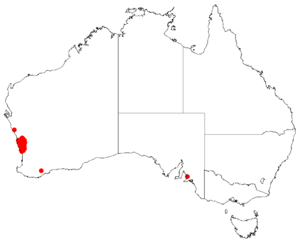Hakea psilorrhyncha facts for kids
Quick facts for kids Hakea psilorrhyncha |
|
|---|---|
| Scientific classification | |
| Genus: |
Hakea
|
| Species: |
psilorrhyncha
|
 |
|
| Occurrence data from Australasian Virtual Herbarium | |
Hakea psilorrhyncha is a special kind of shrub that belongs to the plant family called Proteaceae. It grows naturally in a small area on the west coast of Western Australia, in regions known as the Wheatbelt and Mid West.
Contents
What Hakea psilorrhyncha Looks Like
This Hakea is an upright, very prickly shrub. It usually grows to be about 1 to 4 metres (3 to 13 feet) tall. It has a slim shape and does not grow a special woody swelling at its base called a lignotuber. This lignotuber would normally help it regrow after a fire.
Its leaves grow one after another along the branches. They are round and slender, like a pencil, and are about 2 to 10 centimetres (0.8 to 3.9 inches) long and 1.5 to 2.5 millimetres (0.06 to 0.10 inches) wide. Each leaf ends in a very sharp point. The new branches and leaves often have a rusty colour.
The plant produces clusters of 6 to 8 flowers. These flowers are sweetly scented and are a brownish-yellow colour. They grow where the leaves meet the stem. Each flower cluster sits on a small stalk about 5 to 5.5 millimetres (0.20 to 0.22 inches) long. The individual flower stems, called pedicels, are 6 to 8 millimetres (0.24 to 0.31 inches) long and are covered in thick, silky hairs that can be creamy-white to deep yellow. The flower's outer parts, known as the perianth, are 6.5 to 9 millimetres (0.26 to 0.35 inches) long. The female part of the flower, called the pistil, is 10 to 11 millimetres (0.39 to 0.43 inches) long.
After flowering, large, rough, and corky fruits grow. These fruits are shaped like an egg and are about 3 to 5 centimetres (1.2 to 2.0 inches) long and 1.5 to 2.5 centimetres (0.59 to 0.98 inches) wide. They have a short, curving "beak" at the end. This Hakea flowers during spring, from September to October.
How Hakea psilorrhyncha Got Its Name
The scientific name Hakea psilorrhyncha was first officially described by a scientist named Robyn Mary Barker in 1990. She published her description in a book called Flora of Australia.
The name psilorrhyncha comes from two ancient Greek words:
- psilos, which means "smooth"
- rhynchos, which means "snout"
This name refers to the smooth, beak-like shape at the end of the plant's fruit.
Where Hakea psilorrhyncha Lives
This Hakea plant grows in areas with mallee (a type of eucalyptus woodland) or open heath (a type of shrubland). It prefers to grow in deep sand, loam (a mix of sand, silt, and clay), or clay soils. You can find it from the city of Geraldton in the north, stretching south to Moore River National Park.
Is Hakea psilorrhyncha Endangered?
The Western Australian Government's Department of Parks and Wildlife checks on the health of plants and animals. They have classified Hakea psilorrhyncha as "not threatened." This means that, for now, there are enough of these plants in the wild, and they are not at risk of disappearing.

